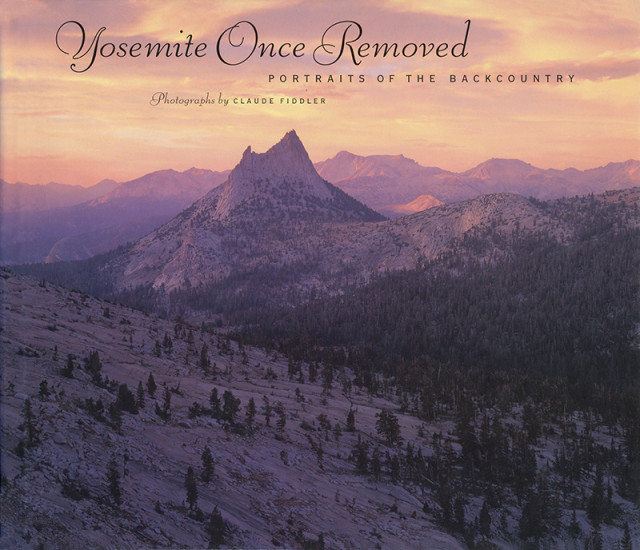
When I told people I planned to hike in to whatever spot in Yosemite National Park was farthest away from any road, a common reaction was this: “I know exactly where it is, and don’t you dare write about it.”
I sympathized with the protective reflex. Publicity is bad medicine for wilderness, sometimes. I would hate to be the one to put on the map some photogenic, fragile, hitherto neglected place. But before sitting down to wrestle with my conscience, I thought I’d at least figure out where the remotest spot might be. Unlike my informants, I didn’t think I knew exactly where it was; in fact, I had no idea . . . .
Evening, the second day. I’m camped in the rain halfway up Falls Creek, legs poked into the warmth of dry goosedown, eating one of my stoveless picnic dinners, watching the lightning open its sudden doors.
The hike has continued as it began: with a constant threat and frequent fact of rain. It’s not yet October, but I’m told it has already snowed on the heights. Clouds and sunlight fight it out all day, constantly reshuffling my sky. Underneath, the country glistens, and it brims. I have lost count of the places where the flooded trail has forced me to wade shin-deep, or to search for the way around that tramples the least fresh grass.
Two days out? It feels like a week. Barring a few brief meetings, I’ve been alone, and solitude speeds up the natural unclenching of the wanderer’s mind. And the way the Falls Creek country has unfolded, page by contrasting page, makes Hetch Hetchy seem already far below and far away.
At noon yesterday, I was still climbing out of the canyon. The landscape there was dun and olive, Californian. The plants were those I know from my coastal home: live oak and poison oak and wild honeysuckle, madrone and sycamore and bay, manzanita and short annual grasses. I had heard how hot this climb can be, and was glad for the cool shadows of the sky.
Two o’clock: The first shallow pond, and a sudden change of colors, as if I’d crossed one of the interior boundaries of Oz. Ahead it was green on green: the ground all bracken and azalea and veratrum; trees mostly true firs, red and white, and Douglas-firs. Charred snags, killed in a recent fire, rose eerily out of it all. Staghorn lichen, as if laid on by a green north wind, softened the living but not the blackened boles.
Eleven this morning: Moraine Ridge, broad-backed, pine-forested. It’s a curious inward salient of the open yellow-pine landscape, spared by the glaciers that gouged and scraped on either side. All around it is austerer country, the land without soil almost, the “real” Sierra. Below to the right is big Lake Vernon on Falls Creek, where I spent last night; looking down to its polished granite and sparse woods is like looking up to timberline.
One o’clock this afternoon: Preliminaries over, the trail spills off Moraine Ridge into the classic Sierra, where all the small shapes and some of the large ones are the creations of ice. This is Jack Main Canyon. “I have been unable to discover who Jack Main was,” wrote J. Smeaton Chase after his 1910 visit, “but I strongly commend his taste in canyons.”
Falls Creek has 6,000 feet of elevation to lose between its sources near Bond Pass on the northern park boundary and its final plunge to Hetch Hetchy at Wapama Falls. That’s a lot of cascading, a lot of noisy water. But for several miles in lower Jack Main Canyon, the stream falls silent. This section of the valley lies across, not up and down, the slope of the Sierra. A long, deep lake must have filled it once: you can tell by the level floor, the sandy soil. Even now it seems half drowned. Everywhere are fragments and scraps of lakes, placid oxbows of stream, wet meadows gleaming around remnant central ponds. At one point I walk on a thin peninsula, no wider than a levee, between a quiet lake on one side and the equally quiet creek on the other; aspens line the path like a planted avenue.
The trail works much harder than the stream, climbing granite noses, threading little woods of cedar or lodgepole or western white pine, passing the flowery spots that Chase called “half-acre gardens.” By the time the valley begins to steepen, I am glad it is time to stop.
Hauling my bear bag into the dripping branches of a lodgepole pine, I startle myself by thinking: I could do this forever. What more do I require than to make and break camp, to give my body what it needs to live, to chart the day’s destination, to move always on? How easy, how involving, how comfortable it all is. At this moment, everything I have valued that requires more of me–the family, the friends, the books, the poetry, the music, the intricate fabric of anyone’s real life—seems utterly expendable. I am taken aback at my treachery.
Sold Out